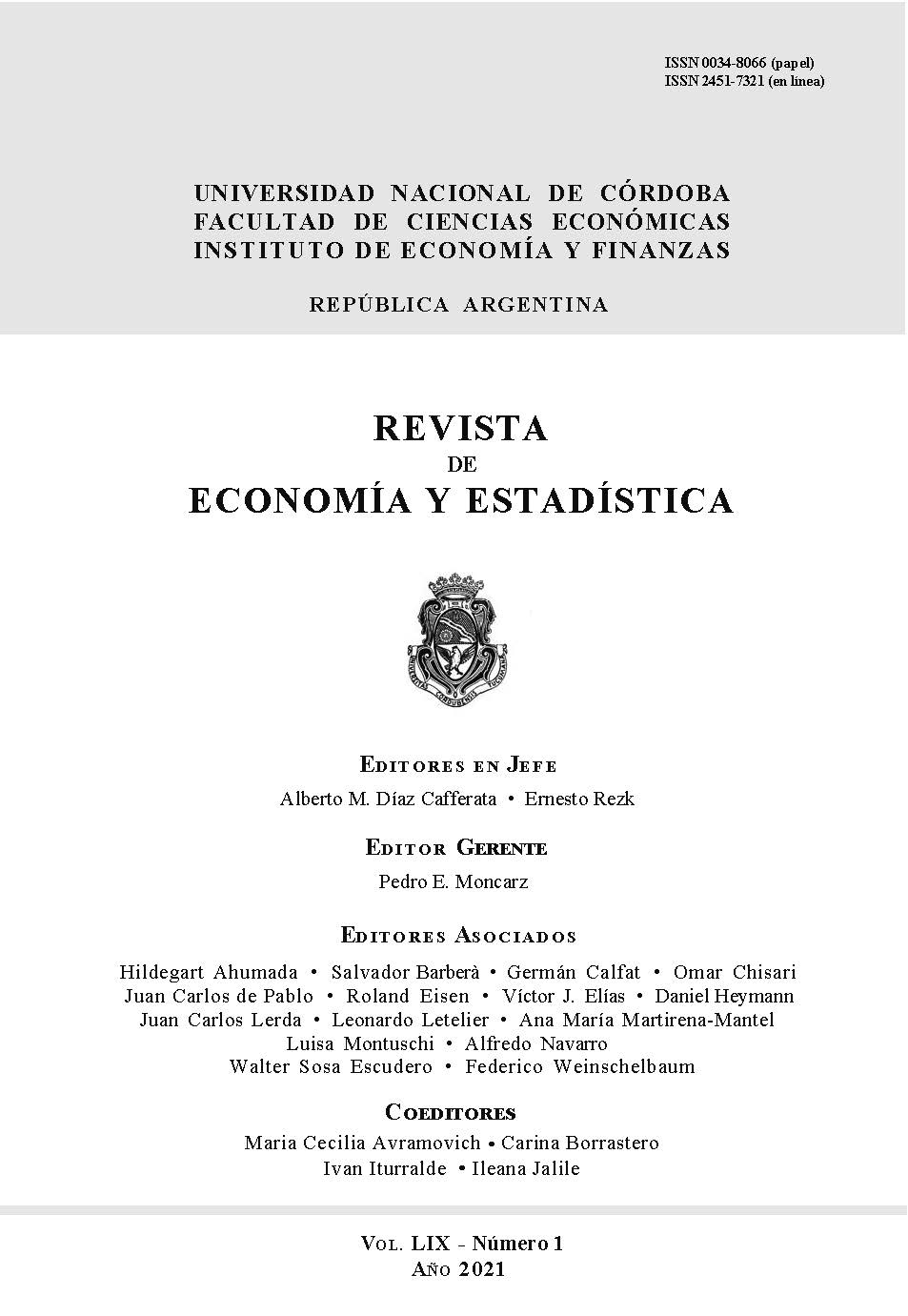A network approach to study the effects of foreign direct investment on economic growth
DOI:
https://doi.org/10.55444/2451.7321.2021.v59.n1.36334Keywords:
Foreign direct investment, networks, economic growthAbstract
Empirical papers on Foreign Direct Investment (FDI) produced ambiguous evidence on the sign and magnitude that it has on economic growth. This paper uses a network approach to evaluate if interconnectedness measures of FDI flows, namely network centrality, have an effect on growth. It uses a database of 175 countries for the 2001-2012 period. Results indicate that there is a negative effect of local centrality (degree) and a positive one for global centrality measures on economic growth. The latter result suggests that the ability of FDI to produce positive effects on economic growth relies on the degree of interconnectedness of the countries to others with a relatively better position in the global investment network.
Reception date: May 4, 2020
Acceptance date: October 24, 2020
Downloads
References
Arrow, K. J. (1969). Classificatory notes on the production and transmission of technological knowledge. American Economic Review, 51 (2), 29-35.
Acemoglu, D., Johnson S. & Robinson J. A. (2001). The colonial origins of comparative fevelopment: An empirical investigation. American Economic Review, 91(5), 1369-1401.
Alfaro, L., Chanda, A., Kalemli-Ozcan, S., & Sayek, S. (2004). FDI and economic growth: The role of local financial markets. Journal of International Economics, 64, 89-112.
Baumol, W. J. (1986). Productivity growth, convergence, and Welfare: What the long-run data show. American Economic Review, 76 (5), 1072-1085.
Bonacich, P. (1987). Power and centrality: A family of measures. American Journal of Sociology, 92(5), 1170–1182.
Borensztein, E., De Gregorio, J., & Lee, J-W. (1998). How does foreign direct investment affect economic growth? Journal of International Economics, 45, 115-135.
Chen, H. & Chen, T-J. (1998). Network linkages and location choice in foreign direct investment. Journal of International Business Studies, 29 (3), 445-469.
Crespo, N. & Fontoura, M. P. (2007). Determinant factors of FDI spillovers - What do we really know? World Development, 35 (3), 410-425.
De Masi, G., Giovannetti, G. & Ricchiuti, G. (2018). A network analysis of italian foreign direct investments. Physica A, 392, 1202-1214.
Findlay, R. (1978). Relative backwardness, direct foreign investment, and the transfer of technology: A simple dynamic model. The Quarterly Journal of Economics, 92 (1), 1-16.
Freeman, L. C. (1978). Centrality in social networks conceptual clarification. Social Networks, 1(3), 215–239.
Jackson, M. O. (2008). Social and Economic Networks. Princeton University Press.
Johanson, J. & Mattson, L.G. (1987). Interorganizational relations in industrial systems: A network approach compared with the transaction-cost approach. International Studies of Management and Orgnaization, 17 (1), 34-48.
Kolaczyk, E. D. (2009). Statistical Analysis of Network Data. New York, NY: Springer Series in Statistics.
Nohria, N. & Garcia-Pont, C. (1991). Global strategic linkages and industry structure. Strategic Management Journal, 12, 105-124.
Page, L., Brin, S., Motwani, R., & Winograd, T. (1999). The PageRank citation ranking: Bringing order to the web. Stanford University Infolab.
Quah, D. T. (1996). Empirics for economic growth and convergence. European Economic Review, 40, 1353-1375.
Romer, P. (1986). Increasing returns and long-run growth. Journal of Political Economy, 94 (5), 1002-1037.
Romer, P. (1993). Idea gaps and object gaps in economic development. Journal of Monetary Economics, 32, 543-573.
Solow, R. M. (1956). A contribution to the theory of economic growth. Quarterly Journal of Economics, 70 (1), 65–94.
Schweitzer, F., Fagiolo, G., Sornette, D., Vega-Redondo, F., Vespignani, A. & White, D. R. (2009). Economic Networks: the new challenges. SCIENCE, Vol 325 (5939), 422-425.
Swan, T. W. (1956). Economic growth and capital accumulation. Economic Record. 32 (2), 334–361.
Wang, J-Y. (1990). Growth, technology transfer, and the long-run theory of international capital movements. Journal of International Economics, 29, 255-271.
World Bank (2017-2018). Global Investment Competitiveness Report. The World Bank, Washington, DC.
Downloads
Published
Issue
Section
License

This work is licensed under a Creative Commons Attribution-NonCommercial-NoDerivatives 4.0 International License.
Authors who have publications with this journal agree to the following terms:
Authors retain their copyright and grant the journal the right of first publication of their work, which is simultaneously subject to the Creative Commons Attribution-NonCommercial-NoDerivatives 4.0 International License that allows third parties to share the work provided that its author and first publication in this journal are indicated.
Authors may adopt other non-exclusive licensing arrangements for distribution of the published version of the work (e.g. depositing it in an institutional telematic archive or publishing it in a monographic volume) as long as the initial publication in this journal is indicated.
Authors are allowed and encouraged to disseminate their work via the Internet (e.g. in institutional telematic archives or on their website) before and during the submission process, which can lead to interesting exchanges and increase citations of the published work. (See The Open Access Effect)










